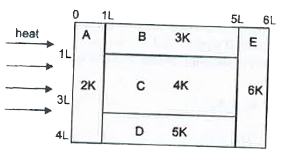A cylindrical rod with one end in steam and other end in ice results in melting of 0.1 g of ice per second. If the rod is replaced by another with half the length and double the radius and 1/4th the conductivity than that of the first, the rate at which the ice melts in g/sec will be : Solution in Kannada
3.2
1.6
0.2
0.1
The correct Answer is:C
Qt=kA(T1−T2)d
This heat is used in melting ice ∴Q=mL.
⇒ mLt=kA(T1−T2)d or mt=kA(T1−T2)Ld
∴ m1t1=k1πr21(T1−T2)Ld1
m2t2=k2πr22(T1−T2)Ld2
∴m1t1×t2m2=k1k2(r1r2)2⋅d2d1=0.1×t2m2=11/4×(12)2×1/21=12
m2t2=0.2 g/sec
Thus correct choice is (c ).
Topper's Solved these Questions
- TRANSFERENCE OF HEAT Book:MODERN PUBLICATIONChapter:TRANSFERENCE OF HEAT Exercise:Multiple Choice Questions (Level - III) Questions From AIEEE/JEE Examination)
Explore 5 Videos
- TRANSFERENCE OF HEAT Book:MODERN PUBLICATIONChapter:TRANSFERENCE OF HEAT Exercise:Recent Competitive Questions
Explore 4 Videos
- TRANSFERENCE OF HEAT Book:MODERN PUBLICATIONChapter:TRANSFERENCE OF HEAT Exercise:Recent Competitive Questions
Explore 4 Videos
- SOLIDS & SEMICONDUCTOR DEVICESBook:MODERN PUBLICATIONChapter:SOLIDS & SEMICONDUCTOR DEVICESExercise:Revision Test
Explore 28 Videos
- UNIFORM CIRCULAR MOTIONBook:MODERN PUBLICATIONChapter:UNIFORM CIRCULAR MOTIONExercise:Revision Test
Explore 57 Videos
Similar Questions
A composite block is made of slabs A,B,C,D and E of different thermal conductivities (given in terms of a constant K) and sizes (given in terms of length, L) as shown in the figure. All slabs are of same width. Heat 'Q' flows only from left to right through the blocks.
Then in steady state

View SolutionTwo slabs are of the thicknesses d1 and d2. Their thermal conductivities are K1 and K2 respectively They are in series. The free ends of the combination of these two slabs are kept at temperatures θ1 and θ2. Assume θ1>θ2. The temperature θ of their common junction is
View SolutionTwo slabs are of the thicknesses d1 and d2. Their thermal conductivities are K1 and K2 respectively They are in series. The free ends of the combination of these two slabs are kept at temperatures θ1 and θ2. Assume θ1>θ2. The temperature θ of their common junction is
View SolutionChoose the forward biased p-n junction :
View SolutionA sphere of mass m is tied to end of a string of length 1 and rotated through the other and along a horizontal circular path with speed . The work done in full horizontal circle is:
View SolutionA cylindrical rod with one end in a steam chamber and the other end in ice results in melting of 0.1 g of ice per second. If the rod is replaced by another with half the length and double the radius of the first and if the thermal conductivity of material of second rod is 1/4 that of first, the rate at which ice melts in g/s will be
View SolutionOne end of conducting rod is maintained at temperature 50∘C and at the other end ice is melting at 0∘C. The rate of melting of ice is doubled if:
View SolutionA cylindrical rod with one end in a steam chamber and the other end is in ice It is found that 1gm of ice melts per second If the rod is replaced by another one of same material double the length and double area of cross section, The mass of ice that melts per second is .
View SolutionOne end of a cylindrical rod is kept in steam chamber and the other end in melting Ice. Now 0.5gm of ice melts in 1sec if the rod is replaced by another rod of same length half the diameter then rate of melting of ice will be (in gm/sec) .
View Solution25 सेमी लम्बी धातु की छड़ का एक सिरा भाप में तथा दूसरा सिरा बर्फ में है | यदि 12 ग्राम प्रति मिनट बर्फ गल रही हो, तो धातु की छड़ की ऊष्मा चालकता ज्ञात कीजिए | छड़ के अनुप्रस्थ काट का क्षेत्रफल 5 वर्ग सेमी तथा बर्फ की गलन की गुप्त ऊष्मा 3.4×105 जुल/किग्रा है |
View Solutionकिसी धातु की 25 सेमी लम्बी छड़ का एक सिरा भाप में तथा दूसरा सिरा बर्फ में है। यदि छड़ की अनुप्रस्थ काट का क्षेत्रफल 5सेमी2 है तथा 12 ग्राम बर्फ प्रति मिनट पिघल रही है, तो छड की धातु का ऊष्मा चालकता गुणांक ज्ञात कीजिए। दिया है : बर्फ के गलन की गुप्त ऊष्मा =3.4×105 जूल/किग्रा।
View SolutionA cylindrical rod with one end in a steam chamber and the other end in ice results in melting of 0.1 g of ice per second. If the rod is replaced by another rod with half the length and double the radius of the first and if the thermal conductivity of material of the second rod is 0.25 times that of first, the rate at which ice melts in gs−1 will be:
View SolutionOne end of 0.5 m long metal rod is in steam at 100∘C and the other end is put in ice at 0∘C. If ice melts at the rate of 10 g/min, calculate the thermal conductivity of the metal. Take, cross sectional area of rod=2πcm2 . Latent ice of heat = 80 cal/g
View SolutionOne end of a cylindrical rod is in the steam chamber and the other end is in the ice, due to which melting 0.1 g of ice per second. This metal rod is replaced by a rod whose length is half the original length and twice the radius. If the heat conductivity of the metal of the second rod is the conductivity of the original rod - how many grams of ice melt per second?
View SolutionOne end of a cylindrical rod is kept in steam chamber and the other end in melting Ice. Now 0.5 gm of ice melts in 1 sec. If the rod is replaced by another rod of same length, half the diameter and double the conductivity of the first rod, then rate of melting of ice will be
View Solution

